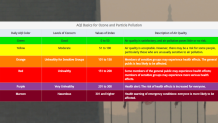Editor's Note: Air quality worsened to code red in the D.C. area on Thursday. Go here for the latest updates.
An air quality alert is in effect in the D.C. area on Wednesday because of smoke from wildfires in Canada. It comes less than three weeks after D.C. was gripped by the worst air quality on record.
All of D.C. and areas to the south and west were under a code orange as of Wednesday evening. A code red was in effect further west, in areas including Front Royal and Winchester. A code yellow was in effect to the north and east.
Under a code orange, people in sensitive groups are advised to stay inside if possible. This includes older adults, children, teens and people with heart or lung disease, AirNow.gov says. Under a code red, the air is unhealthy to breathe; the code orange recommendations apply, plus everyone is advised to spend less time outdoors and choose less strenuous activities.
Use the map below to check air quality in your area.
Local
Washington, D.C., Maryland and Virginia local news, events and information
Haze could be seen over the D.C. skyline early Wednesday. An aerial view from Air Force One showed smoke surrounding the U.S. Capitol.
The air quality in the D.C. area was not expected to be as bad as it was on June 8, when code red, purple and maroon alerts were issued. At one point that day, D.C.’s air quality was the worst in the world. Schools and day cares kept children inside, the Smithsonian’s National Zoo closed and flights were delayed.
A code red air quality alert is expected for Thursday in the D.C. area, the Metropolitan Washington Council of Governments and Clean Air Partners said.

Drifting smoke from the wildfires in Canada lowered curtains of haze on broad swaths of the United States on Wednesday. Across Canada, 490 fires were burning, with 255 fires considered to be out of control.
The small particles in wildfire smoke can irritate the eyes, nose and throat, and can affect the heart and lungs, making it harder to breathe.
The warming planet will produce hotter and longer heat waves, making for bigger, smokier fires, said Joel Thornton, professor and chair of the department of atmospheric sciences at the University of Washington.
What do air quality codes mean?
The Environmental Protection Agency monitors how polluted or clear the air is with the Air Quality Index, or AQI. The scale runs from 0 to 500, and the higher the AQI, the more pollution there is in the air.
Each range on the AQI is given a color. Green is the zero to 50 part of the range, and qualifies as good air quality; yellow is 51 to 100 and qualifies as moderate air quality. Code orange is the part of the range from 101 to 150 and means the air is unhealthy for sensitive groups. A code red, which ranges from 151 to 200, is unhealthy for everyone.
Code purple means everyone is at risk of health impacts. Once you get to 301 and higher, people are more likely to be sickened. See the chart below for the full range of the AQI.

Wildfires release a lot of pollution into the atmosphere. The fine particulate matter in the smoke is especially bad for human lungs and can cause decreased lung function, throat irritation and shortness of breath, according to the EPA. It can also cause bronchitis and asthma, according to CNBC.
According to research from Stanford University, being "exposed to wildfire smoke causing AQI of 150 for several days is equivalent to about seven cigarettes a day if someone were outside the whole time."
Air quality measurements can differ from state to state and county to county, and over time throughout the day.
Is poor air quality rare in DC?
The D.C. Metro area typically sees about 10 or fewer code orange days every year. As of June 8, D.C. had seen eight poor air quality days.
The region had not seen a code red air quality day, excluding fireworks, since Feb. 19, 2011, Storm Team4 Meteorologist Amelia Draper said earlier this month.
"I think this is going to be a common topic for us here this summer, of our poor air quality, at least our hazy skies," Draper said.
How can I stay safe from the smoke in DC?
The best way to protect yourself from the negative health effects of wildfire smoke is to avoid breathing it in — which means staying inside as much as possible.
If you typically work out outside, it could be a good day to hit the gym instead. It's also not a good day to take your kids to the park or the pool, especially if they have allergies, asthma or chronic health issues.
Pets should also stay inside when the air is unhealthy.
“Other mammals, they suffer from many of the same lung conditions that humans do,” Dr. Purvi Parikh, an allergist and immunologist at the Allergy & Asthma Network, told NBC News.
It's a good idea to use the "recirculate" air button in your car.
"This keeps the outside air OUT and keeps sending the inside air through the filters," Storm Team4's Chuck Bell said.
If you need extra protection from smoky conditions, the Centers for Disease Control recommends finding a room you can seal off from outside air. Consider a portable air cleaner or a filter to keep that room clean.
There are ways to create an air filter yourself using a box fan and furnace filters you can purchase at most grocery stores.
Respirators, like N95s, can help reduce your smoke exposure if you have to be outside in poor air quality conditions, according to the CDC.
The Associated Press contributed to this story.
Stay with NBC Washington for more details on this developing story.
News4 sends breaking news stories by email. Go here to sign up to get breaking news alerts in your inbox.



